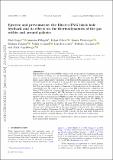Ejective and preventative: the IllustrisTNG black hole feedback and its effects on the thermodynamics of the gas within and around galaxies
Author(s)
Zinger, Elad; Pillepich, Annalisa; Nelson, Dylan; Weinberger, Rainer; Pakmor, Rüdiger; Springel, Volker; Hernquist, Lars; Marinacci, Federico; Vogelsberger, Mark; ... Show more Show less
DownloadAccepted version (6.139Mb)
Open Access Policy
Open Access Policy
Creative Commons Attribution-Noncommercial-Share Alike
Terms of use
Metadata
Show full item recordAbstract
Supermassive black holes (SMBHs) that reside at the centres of galaxies can inject vast amounts of energy into the surrounding gas and are thought to be a viable mechanism to quench star formation in massive galaxies. Here, we study the 10[superscript 9-12.5] M[subscript ⨀] stellar mass central galaxy population of the IllustrisTNG simulation, specifically the TNG100 and TNG300 volumes at z = 0, and show how the three components – SMBH, galaxy, and circumgalactic medium (CGM) – are interconnected in their evolution. We find that gas entropy is a sensitive diagnostic of feedback injection. In particular, we demonstrate how the onset of the low-accretion black hole (BH) feedback mode, realized in the IllustrisTNG model as a kinetic, BH-driven wind, leads not only to star formation quenching at stellar masses $\gtrsim 10[superscript 10.5]M[subscript ⨀] but also to a change in thermodynamic properties of the (non-star-forming) gas, both within the galaxy and beyond. The IllustrisTNG kinetic feedback from SMBHs increases the average gas entropy, within the galaxy and in the CGM, lengthening typical gas cooling times from 10-100 Myr to 1-10 Gyr, effectively ceasing ongoing star formation and inhibiting radiative cooling and future gas accretion. In practice, the same active galactic nucleus (AGN) feedback channel is simultaneously ‘ejective’ and ‘preventative’ and leaves an imprint on the temperature, density, entropy, and cooling times also in the outer reaches of the gas halo, up to distances of several hundred kiloparsecs. In the IllustrisTNG model, a long-lasting quenching state can occur for a heterogeneous CGM, whereby the hot and dilute CGM gas of quiescent galaxies contains regions of low-entropy gas with short cooling times.
Date issued
2020-08Department
MIT Kavli Institute for Astrophysics and Space ResearchJournal
Monthly Notices of the Royal Astronomical Society
Publisher
Oxford University Press (OUP)
Citation
Zinger, Elad et al. "Ejective and preventative: the IllustrisTNG black hole feedback and its effects on the thermodynamics of the gas within and around galaxies." Monthly Notices of the Royal Astronomical Society 499, 1 (July 2020): 768–792 © 2020 The Author(s)
Version: Author's final manuscript
ISSN
0035-8711
1365-2966